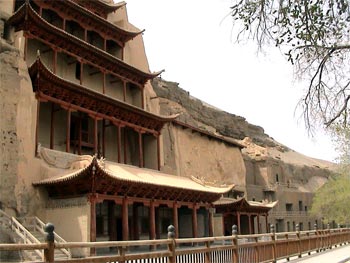Dunhuang is located at the west of Gansu Corridor where it is the intersecting point of Gansu, Qinghai, and Xingjiang province. There are landmarks such as Mogao Caves, the Yang pass (Yangguan), Yumenguan, the waterfall sets at the ruins and so on. Mt. Mingsha, the crescent moon spring, and the elegant Dan landform are also famous.
The Dunhuang Mogao Caves has another name “Thousand Buddhas Cave”, which is situated southeast Dunhuang east 25 kilometer on the foothill cliff of Mt. Mingsha. It was found during the Qin Dynasty. During the reign of Wu Zetian of the Tang Dynasty, there had been thousands of caves. Now there are about 492 caves, which were built during Northern Wei Dynasty, Western Wei Dynasty, Northern Zhou Dynasty, Sui, Tang, the five dynasties, Song, the tangut, and Yuan Dynasty. There are 2400 pieces of color paintings, and the cave paintings cover an area of 45,000 square meters.
There are two stories about the naming of the Mogao caves. 1) Mogao in ancient time was a town, and because it is the hometown of Mogao that people named after it. 2) The second saying insists that it was named after the site where construction was carried out .

Dunhuang Crescent Moon Lake
The crescent moon lake is a magnificent lake in Dunhuang city. The crescent moon lake is located north side the Gansu Province in Dunhuang. It is a lake that lies in the center of the desert. The width between north and south is only 54 meters. It is really a mini lake surrounded by sand.
In the south bank of crescent moon lake a pavilion stands tall and erect. It has empress palace (niangniangdian), dragon royal palace (longwanggong), Bodhisattva palace (pusadian), god of medicine cave (yaowangdong), scripture hall (jingtang), thunder spirit table (leishentai) and so forth. They are surrounded by Mt. Mingsha. Though the crescent moon lake is located in the desert, it never dries up. Most people consider it a wonder.

Dunhuang Mingsha Shan (Echoing Sand Mountain)
Mt. Mingsha is located five kilometers south of Dunhuang city. Through the ages, by “mountain spring coexistence, sand water paragenesis” (a sign of the scenic spot) the marvelous landscape is celebrated worldwide, with the reputation “a pearl north of the Great Wall”. In 1994 it is listed as the national key scenic spot. Mt. Mingsha, the crescent moon spring and the Mogao Caves art landscape merges into a whole which has become a popular tourist attraction all around the world.
Mt. Mingsha acquired the fame because of the special sound made by the moving sands. Ancient times, it was called the “sand Hornberg”, and “the god Shashan”. The length between east and west is 40 km while the south and north is 20km. The Mingsha mountain's peak is like a knife's edge. From far away, it looks like a dragon but also resembles mighty waves in the sea .It is really a magnificent sight to behold.
Dunhuang West Thousand Buddhas Cave
Another historical scenic spot in Dunghuang city is the West Thousand Buddhas Cave.
West Thousand Buddhas Cave is a part of the Buddhism art system. From the Northern Wei Dynasty to Song Dynasty, there are 17 caverns. Among them, caves one to three are from the Tang Dynasty, and cave four to eighth are from Wei Dynasty. The 16th cave was built in the late Tang dynasty. There have difficulty in attempting to identify the time of the other caverns, mainly because there were no such records. But in a historical book titled "Sand State Governor's headquarters Chart ", the volume records that the west Thousand Buddhas Caves were built around the same time as Mogao Caves.
In the near 1000 years of existence, the West Thousand Buddhas Cave has endured nature and man-made destruction which has caused great damages to this ancient artistic treasure house. In recent years, under all levels of government's attention, works such as comprehensive restoration and cave reinforcements were undertaken. Since the restoration project began, the West Thousand Buddhas Cave has been well restored, and about 10 caverns are open to tourists.
|